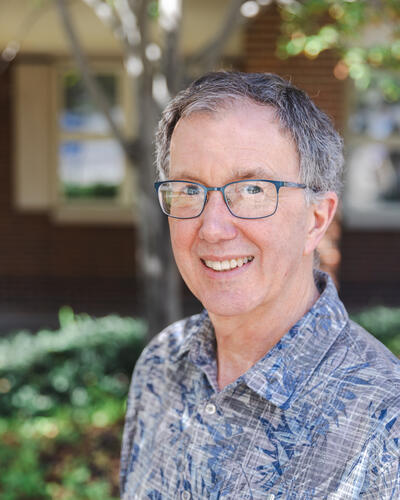Chris Leary has been a member of the Geneseo faculty since 1992.

Curriculum Vitae
Education
B.A., Oberlin College; 1979
Ph.D., University of Michigan; 1985
Employment
SUNY Geneseo 1992-current
United States Agency for International Development (2017-2018)
Eberhard Karls Universität Tübingen, Germany (2005–2006)
The University of Calgary (1998)
Stetson University (1991-1992)
Oberlin College (1985-1991)
Publications
A Friendly Introduction to Mathematical Logic (2nd Edition) (with Lars Kristiansen), (2015), Milne Library, Geneseo NY. Available at http://minerva.geneseo.edu/a-friendly-introduction-to-mathematical-logi…
Fractals, average distance, and the Cantor set (with Dennis Ruppe and Gregg Hartvigsen), Fractals, vol. 18, no. 3 (2010), pp. 327-341.
Component averages in subgraphs of circulant-like graphs (with Jaqueline M. Dresch, Niels C. Hansen, Gregg Hartvigsen and Anthony J. Macula), Bulletin of the Institute for Combinatorics and its Application, vol. 51 (2007), pp. 55-68.
Tuning Degree Distributions: Departing from scale-free networks (with Hans-Peter Duerr, Markus Schwehm and Martin Eichner), Physica A: Statistical Mechanics and its Applications, vol. 382 (2007), pp. 731?738.
The impact of contact structure on infectious disease control: influenza and antiviral agents. (with Hans-Peter Duerr, Markus Schwehm, SJ DeVlas and Martin Eichner), Epidemiology and Infection, vol. 135, no. 07, (2007), pp.1124-1132.
Network structure, population size, and vaccination strategy and effort interact to affect the dynamics of influenza epidemics (with Gregg Hartvigsen, Jacqueline Dresch, Amy Zielinski, and Anthony Macula), The Journal of Theoretical Biology, vol. 246 (2007), pp. 205?215.
High infection rates at low transmission potentials in West African onchocerciasis (with Hans-Peter Duerr and Martin Eichner), International Journal for Parasitology, vol. 36, no. 13 (2006), pp. 1367-1372.
Filter games on omega and the dual ideal (with Claude Laflamme), Fundamenta Mathematicae, vol. 173, no. 2 (2002), pp. 159?173.
The structure of pleasant ideals. Notre Dame Journal of Formal Logic. 1994;35(2):292-98.
Pleasant ideals. Notre Dame Journal of Formal Logic. 1991;32(4):612-17.
Patching ideal families on P-kappa-lambda. Archive for Mathematical Logic. 1990;30(4):269-75.
Patching ideal families and enforcing reflection. J. Symbolic Logic. 1989; 54: 26–37.
Latin square achievement games (with Frank Harary). J. Recreational Mathematics. 1983-1984; 16(4): 241–246.
Research Interests
My research training was in the areas of set theory and logic. In particular, I have published papers dealing with infinitary combinatorics and large cardinals. More recently I have become interested in modeling and applications of mathematics to biology. I have also been fortunate enough to work with members of the Institut für Medizinische Biometrie at the University of Tübingen.
Classes
-
MATH 239: Intro to Mathematical Proof
The course will provide an introduction to the language of advanced mathematics and to mathematical proof. It will emphasize rigorous argument and the practice of proof in various mathematical contexts. Topics will include logic, set theory, cardinality, methods of proof, and induction. Other mathematical topics chosen at the discretion of the instructor will be included as material through which proving skills will be honed.
-
MATH 324: Real Analysis I
A study of the underlying theory of elementary calculus. Topics include the structure and properties of the real numbers, sequences, functions, limits, continuity, the derivative, the Riemann integral, and Taylor's theorems.
-
MATH 360: Probability
Topics include probability definitions and theorems; discrete and continuous random variables including the binomial, hypergeometric, Poisson and normal random variables. Both the theory and applications of probability will be included.